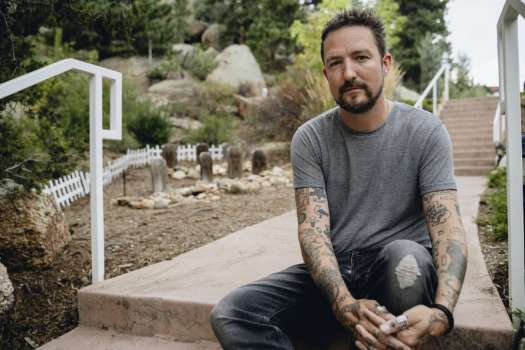The growth of popular music requires the proper growing conditions: an acceptable climate and lots of attention. Traditionally, heavy metal has weathered the roughest storms and the rockiest landscapes to flourish in both populous remote regions. Due to its massive underground fan-base network, metal has long sprouted its own indigenous scenes.
San Francisco
San Francisco and its surrounding suburbs have spawned some of metal's greatest bands, which were continually lumped under the "Bay Area thrash" umbrella. While Slayer (and later Megadeth) were ripping it up around Los Angeles, thrash pioneers Exodus initiated the first wave of Bay Area thrash ominous tunings, ultra-fast riffing, and machine-gun drumbeats until guitarist Kirk Hammett departed to join Metallica, one of metal's most influential acts. The second wave arrived in the late '80s with Testament, Death Angel, Vio-Lence, and Forbidden at the head, while the '90s ushered in a third wave with Machine Head and Skinlab at the forefront.
Defining moments: Metallica Kill 'Em All (Elektra, 1983); Exodus Bonded By Blood (Combat, 1985); Testament, The Ritual (Atlantic,1992); Machine Head Burn My Eyes (Roadrunner, 1994)
New York
The truest melting pot, the great urban sprawl of New York and New Jersey has propagated the most diverse metal scenes from the most disparate elements. Beginning with the early thrash/speed metal of the '80s (Anthrax, Stormtroopers Of Death, Nuclear Assault, Overkill), all derived from punk/hardcore sources, the '90s gave way to smothering death metal (Suffocation, Immolation, Brutal Truth), goth metal (Type O Negative), and the infamous marriage of rap and metal (Biohazard) that has both promoted and plagued the industry ever since.
Defining moments: Anthrax Among The Living (Megaforce/Island, 1987); Brutal Truth Extreme Conditions Demand Extreme Responses (Earache/Relativity, 1992); Biohazard Urban Discipline (Roadrunner, 1992); Type O Negative, Bloody Kisses (Roadrunner, 1993)
Tampa
Considered the birthplace of American death metal with Death's Chuck Schuldiner as its father Tampa has long been a mecca for this gutturally growled, ultra-heavy spin-off of late '80s thrash/speed, making Morrisound Studios and producer Scott Burns an instant ticket to underground stardom. Bands like Cannibal Corpse began relocating to Florida (or just visiting to log studio time, like Sepultura, Napalm Death, Cancer, Exhorder and Suffocation have) by the dozens, with the entire sub-genre reaching a saturation point around 1995 when Scandinavian black metal shifted the focus of fans worldwide.
Defining moments:
Death Scream Bloody Gore (Combat, 1987); Obituary Cause Of Death (Roadrunner, 1990); Morbid Angel Blessed Are The Sick (Combat, 1991); Deicide Legion (Roadrunner, 1992)
Gothenburg
The frozen climes of Sweden have proved the perfect breeding ground for the New Wave Of Swedish Death Metal (NWOSDM), with At The Gates credited as the first band to wed classic death metal brutality to traditional British metal. The subsequent Gothenburg sound was born as the aggression of Entombed and Edge Of Sanity was fused with the melodic fretwork and galloping chords of Iron Maiden with the liberal fluidity of Carcass' Heartwork for good measure. And while their Scandinavian black-metal contemporaries (Mayhem, Burzum, Emperor) were busy committing murders and burning down churches, these crafty Swedes were taking the Gothenburg sound to all corners of the globe.
Defining moments: At The Gates Slaughter Of The Soul (Earache, 1995); In Flames The Jester Race (Nuclear Blast, 1996); Arch Enemy Stigmata (Century Media, 1998)
San Francisco
San Francisco and its surrounding suburbs have spawned some of metal's greatest bands, which were continually lumped under the "Bay Area thrash" umbrella. While Slayer (and later Megadeth) were ripping it up around Los Angeles, thrash pioneers Exodus initiated the first wave of Bay Area thrash ominous tunings, ultra-fast riffing, and machine-gun drumbeats until guitarist Kirk Hammett departed to join Metallica, one of metal's most influential acts. The second wave arrived in the late '80s with Testament, Death Angel, Vio-Lence, and Forbidden at the head, while the '90s ushered in a third wave with Machine Head and Skinlab at the forefront.
Defining moments: Metallica Kill 'Em All (Elektra, 1983); Exodus Bonded By Blood (Combat, 1985); Testament, The Ritual (Atlantic,1992); Machine Head Burn My Eyes (Roadrunner, 1994)
New York
The truest melting pot, the great urban sprawl of New York and New Jersey has propagated the most diverse metal scenes from the most disparate elements. Beginning with the early thrash/speed metal of the '80s (Anthrax, Stormtroopers Of Death, Nuclear Assault, Overkill), all derived from punk/hardcore sources, the '90s gave way to smothering death metal (Suffocation, Immolation, Brutal Truth), goth metal (Type O Negative), and the infamous marriage of rap and metal (Biohazard) that has both promoted and plagued the industry ever since.
Defining moments: Anthrax Among The Living (Megaforce/Island, 1987); Brutal Truth Extreme Conditions Demand Extreme Responses (Earache/Relativity, 1992); Biohazard Urban Discipline (Roadrunner, 1992); Type O Negative, Bloody Kisses (Roadrunner, 1993)
Tampa
Considered the birthplace of American death metal with Death's Chuck Schuldiner as its father Tampa has long been a mecca for this gutturally growled, ultra-heavy spin-off of late '80s thrash/speed, making Morrisound Studios and producer Scott Burns an instant ticket to underground stardom. Bands like Cannibal Corpse began relocating to Florida (or just visiting to log studio time, like Sepultura, Napalm Death, Cancer, Exhorder and Suffocation have) by the dozens, with the entire sub-genre reaching a saturation point around 1995 when Scandinavian black metal shifted the focus of fans worldwide.
Defining moments:
Death Scream Bloody Gore (Combat, 1987); Obituary Cause Of Death (Roadrunner, 1990); Morbid Angel Blessed Are The Sick (Combat, 1991); Deicide Legion (Roadrunner, 1992)
Gothenburg
The frozen climes of Sweden have proved the perfect breeding ground for the New Wave Of Swedish Death Metal (NWOSDM), with At The Gates credited as the first band to wed classic death metal brutality to traditional British metal. The subsequent Gothenburg sound was born as the aggression of Entombed and Edge Of Sanity was fused with the melodic fretwork and galloping chords of Iron Maiden with the liberal fluidity of Carcass' Heartwork for good measure. And while their Scandinavian black-metal contemporaries (Mayhem, Burzum, Emperor) were busy committing murders and burning down churches, these crafty Swedes were taking the Gothenburg sound to all corners of the globe.
Defining moments: At The Gates Slaughter Of The Soul (Earache, 1995); In Flames The Jester Race (Nuclear Blast, 1996); Arch Enemy Stigmata (Century Media, 1998)




